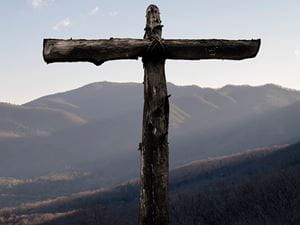
A Celtic cross is a Christian cross featuring a nimbus or ring that emerged in Ireland, France, and Great Britain in the Early Middle Ages. A type of ringed cross, it became widespread through its use in the stone high crosses erected across the islands, especially in regions evangelized by Irish missionaries, from the ninth through the 12th centuries.
A staple of Insular art, the Celtic cross is essentially a Latin cross with a nimbus surrounding the intersection of the arms and stem. Scholars have debated its exact origins, but it is related to earlier crosses featuring rings. The form gained new popularity during the Celtic Revival of the 19th century; the name “Celtic cross” is a convention dating from that time. The shape, usually decorated with interlace and other motifs from Insular art, became typical for funerary monuments and other uses and has remained so, spreading well beyond Ireland.
Origins of the Celtic Cross
While the Celtic Cross is undoubtedly a Christian symbol, it has its roots in ancient pagan beliefs at the same time. The stone circle at Calanais, on the Isle of Lewis in Scotland, is formed in a rough circle, with an even-armed cross within it. This rough circle is believed to be a sun symbol to the creators of the stone circle, which became a sacred shape to the Celts. St Patrick is said to have taken this ancient sun symbol and extended one of the lengths to form a melding of the Christian Cross and the sun symbol, thus the birth of the Celtic Cross.
The even-armed cross within a circle has been credited with many meanings by many groups and cultures. One such definition is the day’s stages: morning, noon, evening, midnight. Another possibility includes the meeting places of the divine energy, self, nature, wisdom, and divinity. Of course, apparent relations such as east, north, south, west, earth, air, water, and fire can also be derived from the shape. Even the Native Americans used this as a symbol for their Medicine Wheel. The sun wheel has also been called Odin’s Cross, a sign in Norse Mythology.
Early Celtic Crosses
Original Celtic Crosses were not carved out of stone. Instead, they were inscribed on the stone, like the cross marker near Gallerus Oratory in Ireland. It is a slab of stone, erected and carved with a Celtic Cross on the surface. Another example is the Edderton Cross Slab in Scotland, made of red sandstone. The Killaghtee Cross in Dunkineely, Ireland, is another example, dating from around 650 CE. This latter example marks the transition from flat grave slabs to the upright Celtic crosses. The top of the carving is a Maltese cross with the triple knot of St. Brigit underneath, representing the Holy Trinity.
Irish high crosses were popular in Ireland’s eighth, ninth, and 10th centuries and were often built to memorialize famous people or places. Over time, they started sporting elaborate carvings, sometimes telling biblical stories. At Clonmacnoise, Ireland, a renowned cross is called the Cross of the Scriptures, or King Flann’s Cross. It is decorated with images from the Bible, such as the Last Supper, the Crucifixion, and the Tomb’s Guarding.
This tendency towards elaborate storytelling through sculpture could imitate Roman sculptures such as Trajan’s Column or the Pictish carvings in Scotland. While many of the stylized designs on the Pictish stones are a mystery, some tell stories of battles and events.
While there are many high crosses throughout Ireland, most Celtic Crosses are those for gravestones, a result of a fashion around the 1850s to use them as headstones or monuments. This style has crossed oceans and taken root wherever Irish or Scottish immigrants landed, be it the Americas, far off Australia, or New Zealand, bringing the beauty and mystery of the Celtic Cross.
The Celtic Revival
The Celtic Revival of the mid-19th century led to increased use and creation of Celtic crosses in Ireland. In 1853, casts of several historical high crosses were exhibited at the Dublin Industrial Exhibition. In 1857, Henry O’Neill published “Illustrations of the Most Interesting of the Sculptured Crosses of Ancient Ireland.” These two events stimulated interest in the Celtic cross as a symbol for a renewed sense of heritage within Ireland.
New versions of the high cross were designed for fashionable cemetery monuments in Victorian Dublin in the 1860s. From Dublin, the revival spread to the rest of the country and beyond. Since the Celtic Revival, the ringed cross became an emblem of Celtic identity, in addition to its more traditional religious symbolism.
Modern interest in the symbol increased because of Alexander and Euphemia Ritchie. The two worked on the island of Iona in Scotland from 1899 to 1940, popularizing the use of the Celtic cross in jewelry. Using the Celtic cross in fashion is still popular today. Since its revival in the 1850s, the Celtic cross has been used extensively for grave markers, straying from medieval usage, when the symbol was typically used for a public monument. The Celtic cross now appears in various retail items. Both the Gaelic Athletic Association and the Northern Ireland national football team have used versions of the Celtic cross in their logos and advertising. The Church in Wales has used a flag with a Celtic cross since 1954.
What the Celtic Cross Symbolizes
As for what the Celtic Cross symbolizes, it’s up for interpretation. Some say the circle stands for the Roman sun-god Invictus, thus giving the name of Celtic Sun Cross. Others say it represents the halo of Jesus Christ. Others see it as a holdover from its pagan roots as a sun symbol. It has been said that St Patrick combined the Christian cross with the pagan sun to give the newly converted followers the idea of the importance of the cross by linking it with the symbolism of the life-giving properties of the sun.
In contrast, others say that placing the cross on top of the circle represents Christ’s supremacy over the sun, which the pagans worshiped. To some people, the Celtic Cross symbolizes the meeting place of Divine energies and can be seen as a symbolic compass, offering spiritual navigation. The circles around the intersection of the cross represent unification, totality, wholeness, and inclusion. With a rich history, the Celtic Cross has picked up numerous symbolizations. Ultimately, the Celtic Cross symbolizes whatever you want it to mean.

